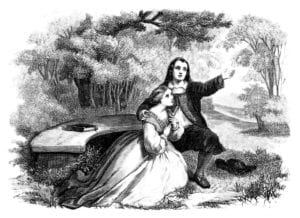Sonnets 49 – 63
Sonnet 49
Summary: the poet anticipates the time in the future when his young love will no longer forgive him his shortcomings and will instead “scarcely greet me”. The poet believes this indifference will be justified (“mine own desert”) since there is no reason to love him in the first place.
Note: the poem is essentially a complex sentence: the first two quatrains constitute a series of subordinate clauses, in turn dependent on the main clause and main verb “I ensconce [= establish] me here”. An extended metaphor of financial and legal terms (“sum / audit / lawful / laws”) runs through the poem.
Question: assess the speaker’s mood here: genuinely humble or too self-effacing to convince?
Sonnet 50
Summary: the speaker travels (on horseback) away from his lover, interpreting his horse’s slow progress as equine intuition that the speaker “loved not speed being made from thee”. Using his spurs on the horse’s flank elicits a groan from his mount, echoing his own grief at parting.
Note: the poet’s reluctant progress is recorded in a poem which ends – symbolically – where it began: with melancholy thoughts for the immediate future and regret for the loss of the recent past. In a largely literal account, it is “anger” personified that “thrusts [the spur] into his hide”.
Question: identify some of the ways in which the octave and the sestet differ from one another.
Sonnet 51
Summary: following on from Sonnet 50, the poet again pictures himself on horseback, travelling away from his lover but imagining returning to him. Then, he believes, he will travel with immense speed, powered by desire and love – though he will forgive his horse its tardiness.
Note: the sonnet is littered with words connoting speed – or its opposite: “slow … speed … haste … posting … swift … slow … speed … pace … race … slow”. The verb “neigh” in line 11 seems to mean “allow”: my desire will permit no malingering (“dull flesh”) when aroused.
Question: how do the various sentence lengths affect our understanding of the poet’s mood?
Sonnet 52
Summary: the poet compares himself to the kind of person – rich, or high-living – who embraces their desires sporadically, lest over-familiarity dull the pleasure. In the same way, the company of his friend should be rationed: when had, enjoyed, and when lacked, anticipated with pleasure.
Note: the poem contrasts the pride and pleasures of the fortunate on one side and the poet’s love for his friend on the other. Broadly, the former occupies the octave while the latter emerges after the volta. The formal address “you” appears in line 9 and line 13: prominent positions in the sestet.
Question: how apt is the comparison? Is meeting a much-loved companion like enjoying an excellent meal?
Sonnet 53
Summary: the poet’s friend evokes images of numerous predecessors as he is compared for his beauty first with Adonis, then with Helen of Troy: his beauty is like the spring and his generosity like summer. Furthermore his constant heart is like no other person’s.
Note: the poet abandons the intimate “thou” form following Sonnet 52, and here uses the formal “you” twelve times in the course of the poem. Is he implying that a sense of distance has arisen between himself and his lover? Is the reference to the youth’s “constant heart” intended ironically?
Question: what evidence has there been in the sonnets so far that the fair youth is to be praised for constancy?
Sonnet 54
Summary: the poet’s predisposition to analogy evokes the rose and the dog-rose: the one may be distilled into rose water because it is genuine; the other will “unrespected fade”. The poet’s “beauteous and lovely youth” is similarly a thing of real beauty, and this will be preserved in verse.
Note: often the poet’s analogy or comparison is structured fairly rigidly: the octave is used as preamble before the sestet allows the youth to be introduced and compared. Here the appearance of the “fair youth” is left until the closing couplet, before he is praised with plain, emphatic power.
Question: is the delayed appearance of the loved one in this poem a crescendo or an anti-climax?
Sonnet 55
Summary: the poet’s hyperbole records his conviction that his friend, immortalised in these sonnets, will prove indestructible, whatever the ravages of war and time. Paradoxically, perhaps, the poem contains no information about the youth such as might enable him to be identified and so live on.
Note: in one respect this poem returns to one of the central themes of the “Procreation Sonnets” (1-17), that the poems confer immortality on the “fair youth”. There may however be a hint of irony in the concluding line (“You … dwell in lovers’ eyes”) since love is traditionally visually impaired.
Question: how persuasive is the closing couplet, given that the forgoing is largely devoted to images of destruction?
Sonnet 56
Summary: let love revive and flourish. Surely it can at least imitate appetite, which is capable of reviving, rather than to be afflicted with a “perpetual dullness”. Rather let love revive like two lovers searching for one another though divided by water, or like summer, made more desirable by winter.
Note: the poem is unclear as to whose love needs to revive – whether that of the poet or of the “fair youth”. It is notable that the sonnet addresses “love” rather than lover, and that (other than in line 5) the second-person pronoun is absent. Also significant may be the image of the lovers separated by water.
Question: is the poem more convincing as referring to the poet’s own emotions or those of the “fair youth”?
Sonnet 57
Summary: the poet offers himself unconditionally to the service of his love, accepting his instructions passively. Though he may himself be tempted to recoil from some of the demands made on him, he will merely take pleasure from the thought that others in his lover’s company are happy.
Note: the poet implies in the sestet that to renounce his own ego in favour of love may not be wholly desirable: he should be “like a sad slave”, he says, and “a fool”. There may also be an implication in lines 9 and 10 that the youth is the cause of jealousy – as Sonnet 41 suggests.
Question: what are the implications if the first letter of the last word in line 13 is capitalised?
Sonnet 58
Summary: the poet confirms it is not his place to enquire into the movements or activities of the “fair youth”. Rather his role is to accept patiently the limitations of his own status. The youth may do as he pleases, and the poet’s role is simply “to wait, though waiting so be hell”.
Note: the poem opens and closes with religious idioms (“god forbid”; waiting is “hell”), but the body of the sonnet contains metaphors drawn largely from legal and commercial sources: “account … liberty … charter … privilege …pardon … crime”. Having been written in the 16th or 17th century, the poem also reflects the barbarity of the age: “slave … vassal …”.
Question: “O let me suffer” – how far is this a representative theme for the Sonnets in general?
Sonnet 59
Summary: if history is given to repeating itself, as some believe, then the “fair youth” must have existed before now and been praised as fulsomely in print (or “character”). If so the poet would like to see what was said, since he is sure that less deserving subjects have indeed been praised before.
Note: syntactically complex. The poem opens with a conditional (“If there be nothing new”) giving way to an interrogative (“how are our brains beguiled?”). Next comes a subjunctive (“O that record could … / Show me …”), followed by adverbial subordinate clauses of time (“Since mind … was done”) and purpose (“That I might see …”). The sonnet closes, as often, with a strong indicative.
Question: reflect on the syntax of the closing couplets of a dozen or so sonnets. What percentage use powerful declarative (or indicative) verbs?
Sonnet 60
Summary: the passing of time is as inevitable as the to and fro of the waves. Birth leads inevitably to old age, and time takes away what it previously provided, making everything prey to “his scythe to mow” and death. But despite these ravages, the poet’s work will endure.
Note: images from the natural world inform a poem from which the “fair youth” is a notable absentee (at least until the last line, where he appears briefly). Elsewhere the poem focuses on “waves”, “the main” [or sea], “parallels” [or trenches] and a “scythe to mow”.
Question: how far is the presence or inspiration of the “fair youth” implied in this poem?
Sonnet 61
Summary: initially the poet believes he lies awake at night because he is pursued by the “fair youth” inclined “into my deeds to pry”. But then he realises that the youth is not the jealous one, and that in contrast to the young man’s indifference, it is the poet who must “play the watchman”.
Note: night is a prominent theme in Shakespeare’s plays, from “A Midsummer Night’s Dream” to “Macbeth”. In the Sonnets, its role is to reflect the poet’s restless craving for the “fair youth”: Sonnets 28 and 43 give a sense of his ambivalence at the visions of his love that night confers.
Question: many Romantic poems are set at night (“Frost at Midnight”, “Ode to a Nightingale”). What impact does night have in Shakespeare’s Sonnets?
Sonnet 62
Summary: the poet believes himself to be more handsome, more shapely and more honest than others. But when he looks at himself in the mirror, he gets quite a different impression, and his conceit seems almost sinful. Only the affection of the “fair youth” entitles him to his self-regard.
Note: like the best sonnets, the poem progresses, and a kind of brief transformation is described. In the octave, the poet suffers from the delusion that he is immensely attractive. But (a key word, especially when placed at the beginning of the ninth line), the appearance of the mirror challenges and changes his misconception.
Question: Hamlet says that theatre should “hold a mirror up to nature”. Do the Sonnets do this?
Sonnet 63
Summary: one day the “fair youth” will be as old as the poet is now, wrinkled and approaching “age’s steepy [hard to reach] night”. Then all his youthful beauty will be a thing of the past, but there will still be evidence of his beauty in the poems, and he will be forever young there.
Note: the poem addresses time (like many of these sonnets – it was a Jacobean preoccupation), and does so through images drawn from the same field: “youthful morn” gives way to “age’s night”, and youth itself is glossed as “spring”. The poems are once again a kind of “memory”, a hedge against Time’s destructive power.
Question: reflect on the connotations in the context of this poem of the last word in line 14.
One Hundred Word Endnote:
Shakespeare seems to have composed his 154 sonnets largely for private entertainment, circulated and appreciated among friends. Their existence was first revealed in a book by Francis Meres in 1598, and two were published in 1599, probably without their author’s permission.
The entire collection appeared in 1609, but there the certainties end. The identity of the dedicatee (“Mr W.H.”) is disputed, and anyway he is not necessarily the subject of the poems; at least two lovers are addressed, and probably more than two; and it is highly unlikely the poems were written in the order in which they are printed.




